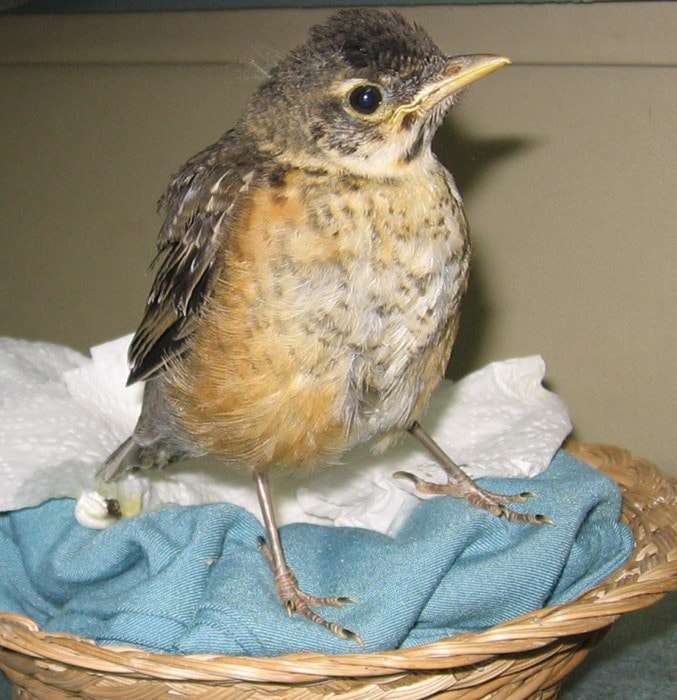If you are an early riser you will certainly be familiar with the "dawn chorus" courtesy of the North American robin.
Any day now M.A.R.S. expects the first of this year's baby robins to arrive at the centre. Contrary to their name these birds are part of the thrush family; they were named by the early European settlers after their much-loved red breasted robins.
Our robins are the first birds to wake up at dawn and the last to retire at dusk when they serenade us with their vast repertoire of melodious tunes and cheeps alerting each other to danger with a piercing alarm call that penetrates the quiet of the forest.
Unmistakable with their cinnamon-rufous breast (the young have speckled breasts), they have dark grey heads and wings with black eyes that are surrounded with a white ring. Unlike many species of birds, both sexes of these robins have similar coloration, the male being more vibrant.
Usually it is easy to figure out what a bird eats by the length and shape of its beak. Seed eaters have short sturdy beaks designed for cracking open the seed shells, raptors have sharp hooked beaks used for tearing meat and robins have longer, more slender beaks equipped to probe in the ground for worms or to catch insects and also for plucking berries. Robins are fascinating to watch as they tenaciously pull and probe in the garden until they manage to dislodge the worms. North American robins spend a lot of their time running and hopping on the ground stopping frequently to listen for prey balancing on their wing tips.
Found throughout North America, our local populations migrate further south for the winter, leaving in early fall, returning in mi- to late-March when the ground has thawed. This year there were large flocks of robins in early-March as they were fooled into thinking spring had arrived.
Robins have a varied diet; they will eat many different food from worms and insects to a variety of berries, and even fish fry which they catch in shallow water. They have adapted well to backyard feeders and are equally at home in the forest or in urban areas.
Robins can often be seen trying to catch as many worms as they can fit in their mouth and one wonders how they can swallow. Nature has provided them with an expandable esophagus which acts as a 'storage container' providing them with food to sustain them through the cold nights, or extra food when feeding hungry babies.
Robins are one of the first birds to produce young in the spring and can often produce more than one clutch during the breeding season. Courtship resembles the feeding young when the birds gape with open mouths whilst quivering their wings; in addition they serenade each other with continuous singing.
Nest building is an elaborate feat of engineering, a cup shaped nest is constructed using twigs and dried grasses and once the cup is built the robin will custom finish the nest with a soft mud lining. The mud is collected, mixed with saliva and the female then sits and wiggles into the mud creating a custom-made nest. Robins are 'altricial birds,' meaning they hatch naked and blind and totally dependent on their parents for food. The babies grow at a rapid rate and have voracious appetites. Once ready to fledge, they will jump, fall or get pushed from the nest; at this time they are unable to fly and will spend a few days running along the ground exercising their wings in preparation for flight but they still beg for food.
This is a critical time for the young robins as they have many predators waiting for an easy meal; it is also the time when the parents teach the young how to hunt and stay safe. Fledgling birds may seem abandoned but often the parents are close by waiting for danger to go away.
Please call M.A.R.S. before attempting to rescue, relocate or pick up baby wildlife, its best chance for survival is with the parents, baby mammals need their mother's milk to pass along crucial antibodies. To report injured, or suspected orphaned wildlife please call 250-337-2021. For further advice, to check our special events or to follow patients progress please visit our web site at www.wingtips.org.
Sandy Fairfield is the educational co-ordinator for the Mountainaire Avian Rescue Society (MARS). The MARS column appears every second Thursday.
